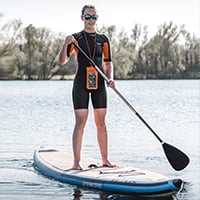
HIKING BOOTS – A GUIDE
Our guide should hopefully make your decision easier!
Your hiking boots can really determine your experience on the trail. Their job is to protect your feet and keep them comfortable – so they feel good both during and after long walks. Unsurprisingly, this means that they must be adapted to your hiking methods, where you hike and of course, to your own feet. This guide aims to help you find the best hiking boots or shoes for you.
10 tips for your hiking boots:
- Use hiking boots in tough terrain and whilst carrying heavy loads
- Use hiking shoes in easier terrain and when you’re carrying less weight
- The heel should be in a steady position
- If your regular size in shoes feels loose in your hiking boots, try another model
- Leave 1-1.5 cm between your toes and the boots for a good fit
- Leave 0.5-1 cm between your toes and the shoes for a good fit
- Use two pairs of socks to reduce the risk of chafing
- Your socks should reach higher up your leg than your boots
- Try on boots at the of the day when your feet are a bit more swollen
- Get used to your boots by wearing them before going on a hike
Take good care of your new friends!
- Grease your boots thoroughly after the first three or four times you use them
- Clean your boots with lukewarm water, don’t dry them in a drying cabinet
- Remove the inner soles and keep your boots in cool conditions between hikes
Terrain and climate
Think about what kind of terrain you’ll be walking over and what the climate will be like. If you’re hiking the Camino de Santiago in Spain you’re better off with a pair of ventilating mesh walking shoes, whilst the King’s Trail in the Swedish mountains is going to demand a higher level of waterproofness. In all cases, however, your boots or shoes need to be stable and protect against irregularities in the ground’s surface. A lower-cut model is often the best choice when walking with a lighter bag and if you require more flexibility from your shoes. Higher-cut models offer higher stability when carrying heavier bags and provide better support for your ankles.
Fit and feel
The weight of your backpack or rucksack will push your feet forward on slopes. So, it’s a good idea to try your boots on an incline while carrying some weight. Hiking shoes require less space in front of your toes as they can be laced tighter and their fit is more similar to that of running shoes. Your heel should sit steady in the back of the shoe and not experience any vertical movement when you’re walking. If you try on shoes in your regular size and the heel still feels loose, it’s probably this particular model that’s the problem. We recommend trying a different model rather than trying another size.
Socks
Use two pairs of socks to reduce friction and the risk of abrasion. Hiking socks are often made from merino wool which has ventilating capacities and offers a sort of chimney-like effect – leading warm air upwards. Because of this, it’s important that your socks reach further up your legs than your footwear, since no chimney ends under the roof. The thinner inner sock should stretch higher than the outer sock for the sake of comfort.
Hiking boots: FAQs
- I have a pair of running shoes that I like to walk in as well, can I use them for hiking?
Running shoes can be really comfortable on asphalt and other even ground. But if you’re walking on paths through the woods or along hiking trails you’ll need a stiffer sole that protects your foot from the uneven ground. You’ll definitely notice the difference, especially when you’re carrying weight and your step gets heavier and heavier.
- Do my shoes or boots have to be waterproof?
It’s generally better to have a pair of hiking boots that are waterproof so that you’re protected from unforeseen rain showers, muddy puddles etc. However, if you’re walking across simpler terrain and wearing a lower walking shoe (especially in warmer climates) a non-waterproof model can be a good option as it offers better ventilation and will most likely dry quicker if it gets wet.
- Do I have to lace my boot all the way up?
Nope. It’s best to lace your boots all the way to the top when you’re crossing miserable terrain and you need the extra stability. But, when the ground evens out again, you’re free to enjoy the luxury of looser lacing which offers improved flexibility and higher ventilation.
- Everybody goes on about merino wool socks. Can’t I just wear cotton or synthetic socks?
Sure you can. But the higher your comfort, the better your experiences in nature will be. Amongst all the good reasons to choose merino wool, two particularly stand out. Merino warms your feet even whilst wet, cotton and synthetics don’t. The view from that peak you just climbed won’t be as pleasant when your feet are cold. Merino also naturally prevents bad smells. It’s often enough to bring two pairs of merino socks with you on a long hike, whilst with cotton or synthetics ones you’d have to devote half your backpack to socks.
- My feet aren’t the same size, what should I do?
Pick your size according to the biggest foot. Boots that are too tight are a problem without a solution; you’ll risk chafing, tension and bad blood circulation. If it feels very uneven, try a combination of thinner merino socks on the bigger foot.
































